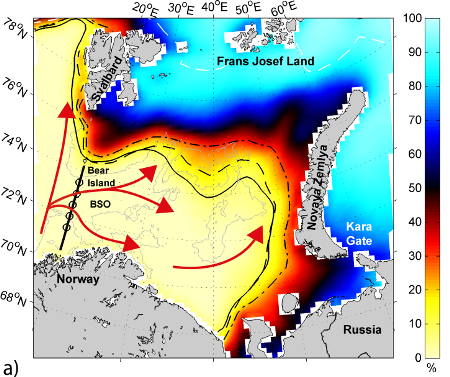The Arctic sea ice cover helps in detecting climate change and variability, according to a new study published in the Journal of Climate by scientists from the Bjerknes Centre for Climate Research (University of Bergen, Uni Research, and Institute of Marine Research).

Map of the Barents Sea showing mean winter sea ice concentration between 1979 and 2010 (colormap) and main paths of Atlantic water (red arrows). Winter ice extent (15% concentration) during the 1980s (solid line), 1990s (dashed) and 2000s (dash-dotted) is also shown.
The Bjerknes Centre for Climate Research scientists have for the first time measured the influence of Atlantic heat on the sea ice extent in the Barents Sea, which has the most pronounced Arctic winter sea ice retreat.
In the Barents Sea, there is a gradual decrease in the winter sea ice extent over the past thirty years, with a 50% reduction in the annual mean sea ice area during the past decade between 1998 and 2008. According to the study, the long-term decrease and inter-annual variability in sea ice cover indicate variations in the inflow of Atlantic water.
This warm water makes the northward flow off the Norwegian coast and towards the Barents Sea as a Gulf Stream extension. Findings from a numerical ocean model and measurements obtained from the south-western Barents Sea have reported that increased heat transport, which is a product of variations in current speed and temperature, related to Atlantic water causes a larger area without wintertime freezing.
Hence most of the sea ice retreat is not melted ice, this particular sea ice never froze. Hence, the process is basically different from the observed retreat in summer sea ice in the central Arctic.
Disclaimer: The views expressed here are those of the author expressed in their private capacity and do not necessarily represent the views of AZoM.com Limited T/A AZoNetwork the owner and operator of this website. This disclaimer forms part of the Terms and conditions of use of this website.